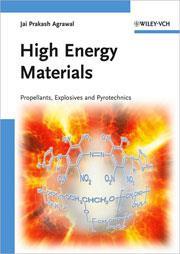High energy materials
High energy materials
J P Agrawal
Weinheim, Germany: Wiley-VCH 2010 | 498pp | ?130.00 (HB)
ISBN 9783527326105
Reviewed by M Eamon Colclough

This book is an excellent overview of the field of energetic materials, well structured in terms of materials and applications.
Chapter 1 describes the basics of what explosives are, how they work and how they are used, with basic data on sensitivity, oxygen balance and heats of formation.
Chapter 2 examines the status of common explosive materials and provides data on basic properties to assess their use in military and civil applications.
Chapter 3 concentrates on processing techniques, formulation of explosives and experimental assessment of explosives. A good summary of casting, extrusion and pressing is given, highlighting that the processing technique is specific to the formulation and the ultimate application of the formulation. Melt cast, aluminised, sheet and polymer bonded explosives are discussed and the benefits in terms of performance, safety and cost are exposed. The laboratory assessment of sensitivity, stability and performance are discussed; however, theoretical calculation of properties is mentioned only briefly and this is an area of increasing importance in terms of assessing material in a cost effective manner.
Chapter 4 gives an excellent summary of the types of propellants in the form of diagrams based on application, physical state and nature. The different types of ingredient are reported against application and there is a good summary of energetic binders - materials with great potential, but as yet struggling to get realised on a commercial basis. Stabilisers, burn rate modifiers, plasticisers, bonding agents and curing agents are all summarised.
Chapter 5 systematically presents pyrotechnics, with extensive detail on ingredient properties.The range of applications of pyrotechnics is given with techniques for measuring their performance. There is a good section on nanomaterials and their uses in propellants, pyrotechnics and explosives.
The final chapter covers the most important aspect of energetic materials which is how to work with them safely. Aspects of handling storage and transportation are summarised.
Overall this book will be extremely useful to anyone in the field of energetic materials as a first point reference book, backed up by an excellent list of up to date references.












No comments yet